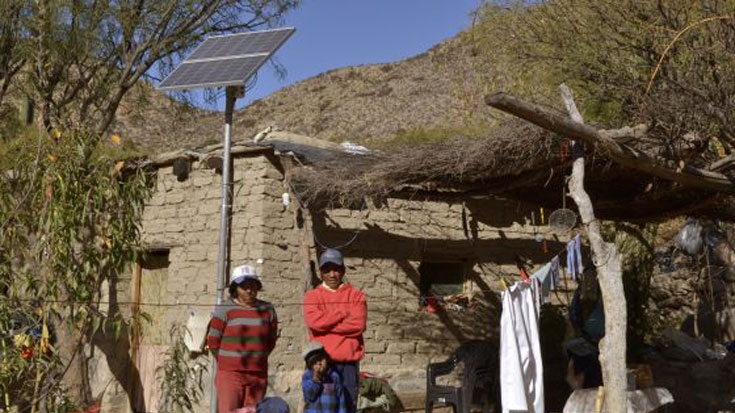“Can you see the steam coming out?” asks Sara as she fills a pot with hot water from a faucet in a rural school in Tucumán, in northern Argentina. There, hundreds of children sit down to enjoy mate cocido – an herbal tea – and bread that Sara prepared herself. Many of the children need an energy boost since they’ve already travelled several kilometers by bicycle, mule or on foot to get to school.
Outside, stunning mountains and multicolored valleys are part of the landscape. Both the classrooms and the school cafeteria have hot water heaters and solar panels to supply heat and electricity to the classrooms. Solar energy provides light to the school in this community, where there has never been an electric power line.
Like most middle-income countries in Latin America, Argentina has a high electrification rate: an estimated 98% of the population has access. The Argentine electric power system is the third largest in Latin America and relies heavily on thermal power —accounting for 60% of the matrix— and on hydroelectric energy at 36%. Demand is highly concentrated in urban areas.
Nevertheless, the country’s size, geography and the low density of its rural population continue to impede universal electric power access at a reasonable cost. Thus, many people have no access to modern energy services and many others only have partial, inadequate and inefficient service, which means just a few hours of service a day. Additionally, service depends on fuel transport, which is costly and difficult given the isolation and inaccessibility of rural communities.
It is estimated that 750,000 people —most of whom belong to indigenous communities— still do not have access to this service, which limits their social and economic opportunities. “It is quite difficult to reach some areas with traditional electric power services,” says World Bank energy specialist Lucia Spinelli.
“The advantage of renewable energies is that they can provide service in those isolated areas,” explains the expert. “Once installed, the service can operate; it is not necessary to have a fuel supply to guarantee electric service to these people,” she says.
Cook, Bath and Connect With Renewable Energies
To date, some 150,000 people in remote regions of Argentina use renewable energies - solar panels, hydroelectric systems and wind energy- for lighting homes, charging cellphones and even listening to the radio.
“The photovoltaic systems (solar panels) installed in homes is what we refer to as basic electrification,” says Spinelli.
“It’s amazing how much the sun can give us,” says Fanny Ávalos, the kindergarten teacher at Manuela Pedraza School, which is one of the 3,000 public buildings -most of which are schools- where solar panels and solar-powered water heaters, stoves and ovens have been installed.
“The kids were very happy when they installed the system. For years, their parents and grandparents relied on candles or kerosene lamps,” she says. All of these activities formed part of a renewable energy project for rural areas implemented by the Argentine Environmental Secretariat, with support from the World Bank and the Global Environment Facility (GEF).
Argentina is not the only country where the sun shines on renewable energies. According to WWF Latin America, 19 of the 26 countries of the region have programs to provide clean energy to rural areas. Peru is one such nation. It currently has a plan in place to provide solar power to 500,000 poor households. According to the organization, “solar power has proven to be a good alternative to resolve energy poverty.”
A Step Closer to Universal Access
Nevertheless, Argentina wants to go further. “The goal now is to reach even more isolated areas with basic electric service,” says Spinelli, with respect to the new support the country will receive and which will enable it to progress in its efforts to guarantee universal energy access.
This renewed support is expected to give an additional 560,000 people access to electricity for lighting, communications and other services, such as pumping water.
“This is done in a sustainable way, both from an environmental perspective as well as from the standpoint of system operation because it ensures that the systems continue to function over time,” says the expert. This requires each zone to have an entity responsible for system operation and maintenance. “The beneficiary becomes a service user, not an owner of the system,” stresses Spinelli.
“This service has characteristics that differ from those of the integrated electric system but that definitely improve the lives of people,” she says.
In this new phase, larger solar panels will be installed in public institutions, which will indirectly benefit some 200,000 people. “These are more complex systems which provide the same service as that of traditional service,” says Spinelli.
Mini-networks will also be financed in small rural communities. These are electric power systems that can combine different resources such as solar panels and hydraulic energy – and power lines to supply all the homes in the community. In recent years, 2,000 of these systems have been installed in the country.

